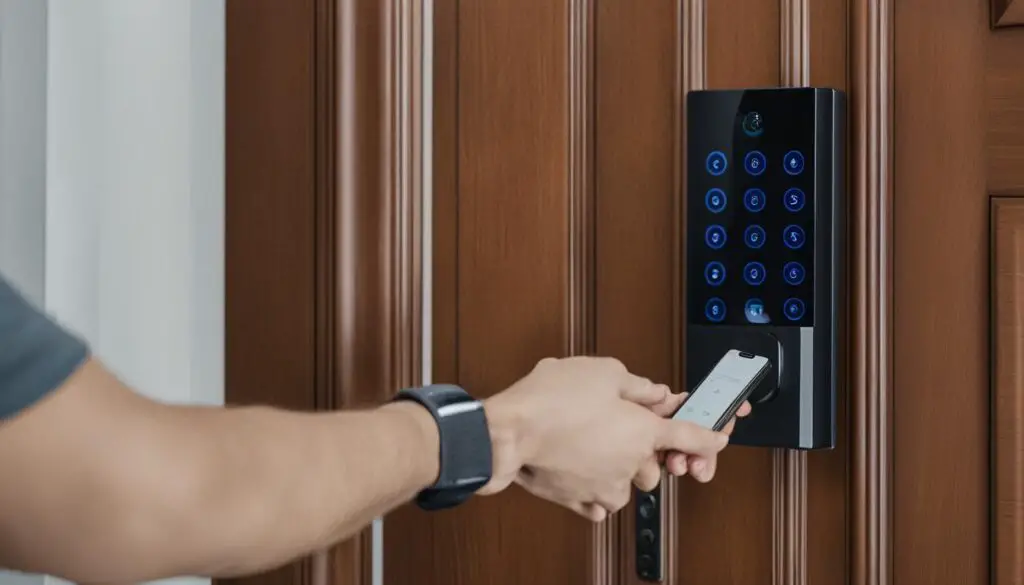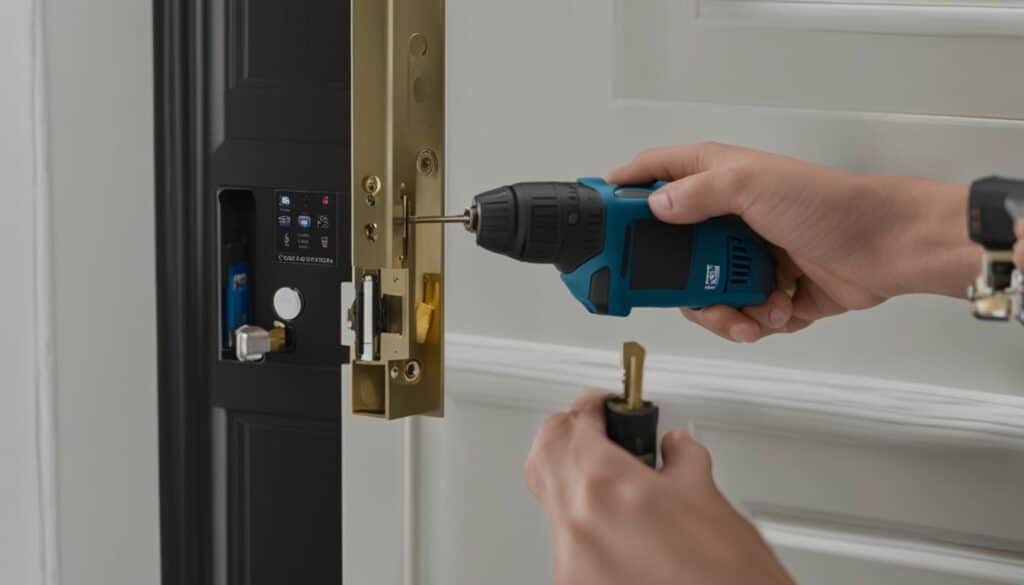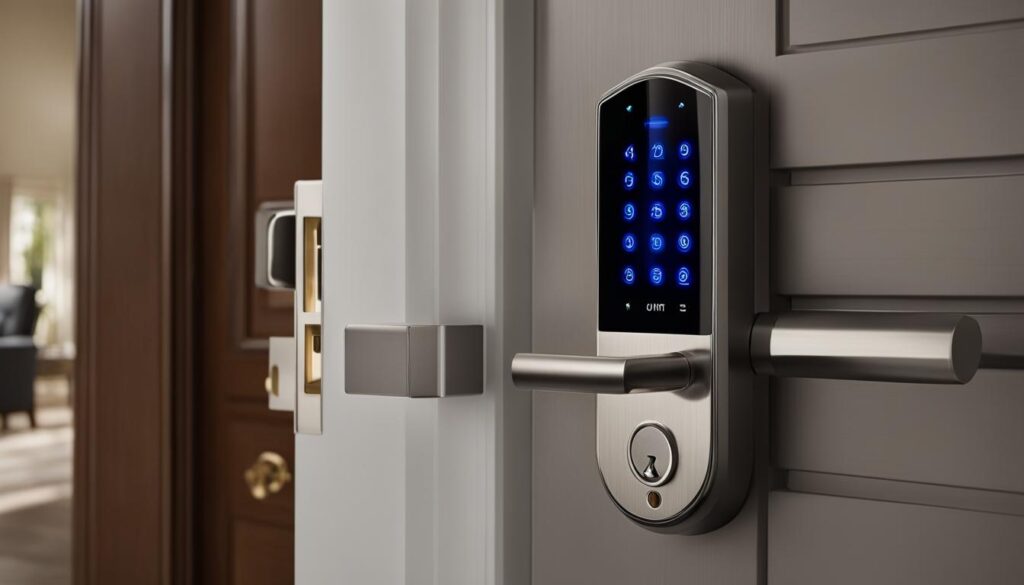Hello there! If you’re new to the world of home security and looking for a convenient and modern way to protect your home, you’ve come to the right place. In this guide, I’ll walk you through the ins and outs of entry-level smart locks and why they are a great choice for enhancing your home security.
Table of Contents
Key Takeaways:
- Smart locks offer convenience, accessibility, and enhanced protection for your home.
- Entry-level smart locks are designed for easy installation and use, making them ideal for beginners.
- These locks eliminate the need for keys and allow remote access via smartphones or connected devices.
- Entry-level smart locks provide additional security features like mobile alerts and tamper detection.
- They can be integrated into a wider smart home system for seamless automation.
Now, let’s dive deeper into the basics of smart locks and explore their benefits and features!
The Basics of Smart Locks
Smart locks are electronic devices that provide an alternative to traditional key-based locks. They utilize innovative technology to enhance home security and offer convenient features for homeowners. With the ability to control them remotely using a smartphone or other connected devices, smart locks provide a new level of accessibility and control.
Entry-level smart locks are specifically designed with simplicity in mind, making them an ideal choice for beginners. These user-friendly devices prioritize easy installation and intuitive operation, ensuring a seamless transition into the world of smart home security.
Whether you’re looking to upgrade your current lock system or enhance your home’s security, entry-level smart locks offer an excellent starting point. By familiarizing yourself with the basics of these locks, you can make informed decisions and take advantage of their advanced features.
Key Features of Entry-Level Smart Locks
- Remote Access: Control your lock from anywhere using a smartphone or connected device.
- Keyless Entry: Eliminates the need for traditional keys, providing convenience and flexibility.
- Easy Installation: Designed for hassle-free setup with step-by-step instructions.
- Integration Capabilities: Compatible with other smart home devices for enhanced automation.
- Sleek Design: Stylish and modern, blending seamlessly with any home decor.
“Entry-level smart locks are the perfect entry point for beginners, offering a simple and user-friendly experience while still providing advanced security features.”
With entry-level smart locks, you can embrace the convenience and peace of mind that come with modern home security. These locks serve as a reliable foundation for building your smart home ecosystem and can be easily expanded upon as your needs evolve.
| Advantages | Disadvantages |
|---|---|
| Convenient and keyless entry | Dependence on technology and power supply |
| Remote access and control | Potential vulnerability to hacking |
| Integration with smart home systems | Compatibility limitations with older door models |
| Enhanced security features | Higher initial investment compared to traditional locks |
Benefits of Entry-Level Smart Locks
Entry-level smart locks offer numerous benefits that can greatly enhance your home security. With their advanced technology and convenience, these smart locks are an ideal choice for homeowners looking to upgrade their locking system. Here are some key benefits of entry-level smart locks:
Convenience and Keyless Access
One of the standout advantages of entry-level smart locks is the elimination of traditional keys. With these locks, you no longer need to carry around a bulky keychain or worry about losing your keys. Instead, you can conveniently unlock your door using a variety of methods, such as smartphone apps, keypads, or even voice commands.
Remote Access and Control
Entry-level smart locks allow you to control and monitor your locks remotely. Whether you’re at work, on vacation, or simply away from home, you can easily check the status of your locks and lock or unlock your doors with a simple tap on your smartphone. This convenient feature provides peace of mind and ensures that you never have to worry about whether your doors are securely locked.
Enhanced Security Features
Smart locks offer several security features that go beyond traditional locks. With mobile alerts, you can receive notifications on your smartphone whenever someone enters or exits your home. This allows you to keep track of who is entering your property and can be especially useful in monitoring the activities of children, housekeepers, or other authorized individuals.
Tamper detection is another valuable security feature of entry-level smart locks. These locks can sense and alert you to any tampering attempts, such as forced entry or manipulation of the lock mechanism. This immediate notification allows for quick action and can help prevent potential break-ins.
Integration with Smart Home Systems
Entry-level smart locks can seamlessly integrate with other smart home devices and systems, providing a comprehensive home automation experience. You can connect your smart lock to your existing smart home hub or system, allowing you to control and coordinate various aspects of your home security, such as locking your doors, turning on lights, or adjusting your security cameras.
With their convenience, remote access, enhanced security features, and compatibility with smart home systems, entry-level smart locks are a valuable addition to any home security setup. Investing in these locks can provide you with peace of mind, convenience, and a heightened level of protection for your home and loved ones.
Factors to Consider When Choosing an Entry-Level Smart Lock
When it comes to choosing the perfect entry-level smart lock for your home, there are a few important factors to keep in mind. These factors will ensure that you make an informed decision and select a lock that meets your specific needs and requirements. Here are the key factors to consider:
- Compatibility with Existing Door Hardware: Make sure that the smart lock you choose is compatible with your existing door hardware. This will ensure a seamless installation process and prevent any compatibility issues.
- Wireless Connectivity Options: Check the wireless connectivity options of the smart lock. Look for locks that offer reliable and secure connectivity, such as Bluetooth or Wi-Fi, for smooth operation and remote control capabilities.
- Battery Life: Consider the battery life of the smart lock. Look for locks that have long-lasting batteries or offer convenient battery replacement options to avoid frequent battery changes.
- User-Friendly Interface: Opt for a smart lock that has a user-friendly interface. This will make it easier for you and your family members to access, operate, and customize the lock to your preferences.
“Choosing the right entry-level smart lock is crucial for the security and convenience of your home. By considering factors like compatibility, wireless connectivity, battery life, and user interface, you can ensure a smart lock that suits your needs and delivers an enhanced level of security.”
Furthermore, it is important to choose a reputable brand with a proven track record of reliability and excellent customer support. This will give you peace of mind knowing that you are investing in a high-quality product that will stand the test of time.

Installation and Setup Process for Entry-Level Smart Locks
Installing and setting up entry-level smart locks is a straightforward process that can be completed by following step-by-step instructions. These locks are designed with simplicity in mind, allowing even beginners to easily get them up and running. Here’s a guide on how to install and set up entry-level smart locks:
Step 1: Gather the necessary tools
Before starting the installation, make sure you have the following basic tools on hand:
- Screwdriver
- Drill (if required)
- Tape measure
Step 2: Prepare the door
Ensure that your door is ready for the smart lock installation. This includes checking if the existing door hardware is compatible and making any necessary adjustments or replacements.
Step 3: Install the smart lock
Follow the provided instructions to install the smart lock onto your door. This usually involves removing the existing deadbolt and replacing it with the smart lock. Secure the lock in place using the provided screws.
Step 4: Connect to the smartphone app
Most entry-level smart locks can be connected to a smartphone app for remote access and control. Download the compatible app onto your smartphone and follow the instructions to connect the lock to the app via Bluetooth or Wi-Fi.
Step 5: Configure access codes and permissions
Once the smart lock is connected to the app, you can configure access codes and permissions for different users. Set up unique codes for family members, trusted friends, or service providers. You can also customize permissions and set schedules for specific access times.
Quote:
“Installing an entry-level smart lock is a DIY-friendly project that doesn’t require any advanced technical skills. With just a few basic tools and following the provided instructions, you can have your smart lock installed and set up in no time.” – Smart Home Magazine
By following these steps, you’ll have your entry-level smart lock installed and ready to enhance your home security. Enjoy the convenience and peace of mind that comes with remote access and control of your front door.

In the next section, we’ll explore essential tips for maximizing security with entry-level smart locks.
Tips for Maximizing Security with Entry-Level Smart Locks
While entry-level smart locks provide enhanced security features, it’s important to take additional precautions to maximize their effectiveness. Here are some tips to ensure the utmost security for your entry-level smart locks:
- Set strong access codes: When setting up your entry-level smart lock, choose a passcode that is long, unique, and hard to guess. Avoid using common combinations like birthdays or addresses.
- Regularly update firmware: Manufacturers frequently release firmware updates for smart locks to address security vulnerabilities. Stay updated with the latest firmware versions and regularly update your lock to ensure the highest level of security.
- Enable two-factor authentication: Two-factor authentication adds an extra layer of security by requiring a secondary verification method, such as a fingerprint scan or an authentication code, in addition to your access code.
- Monitor access logs: Many entry-level smart locks enable you to view access logs, which provide a detailed record of every entry and exit. Regularly check these logs to identify any unauthorized access attempts.
- Keep traditional backup keys: Despite the convenience of smart locks, it’s always a good idea to keep traditional backup keys as a failsafe. In case of emergencies or malfunctions, having physical keys can provide immediate access to your home.
By following these tips, you can maximize the security of your entry-level smart locks, giving you peace of mind and confidence in your home’s protection.
Remember, while entry-level smart locks offer advanced security features, no system is entirely foolproof. It’s crucial to implement multiple layers of security, including alarms, surveillance cameras, and secure Wi-Fi networks, to ensure comprehensive home security.
Best Practices for Maintaining Entry-Level Smart Locks
Regular maintenance is crucial for keeping your entry-level smart locks in optimal condition. By following these best practices, you can ensure their longevity and reliable performance.
- Clean the lock’s exterior: Regularly wipe down the lock’s surface with a soft, dry cloth to remove dust and debris. Avoid using harsh chemicals or abrasive materials that could damage the finish.
- Replace batteries as needed: Keep track of your smart lock’s battery life and replace them promptly when they run low. This will prevent any interruptions in functionality and ensure continuous operation.
- Test the locking mechanism: Periodically test the lock’s locking and unlocking capabilities to make sure it’s functioning properly. This will help identify any issues early on and allow for timely repairs.
- Keep software/firmware up to date: Check for software updates or firmware upgrades provided by the manufacturer. Keeping your smart lock’s software up to date will ensure it has the latest security features and bug fixes.
- Follow manufacturer guidelines: Always refer to the manufacturer’s instructions and guidelines for maintaining your specific entry-level smart lock model. This will help you avoid any potential issues and maximize the lock’s performance.
- Seek professional assistance when necessary: If you encounter any technical problems or complex issues with your smart lock, don’t hesitate to seek assistance from a professional locksmith or the manufacturer’s customer support.
By following these maintenance best practices, you can enjoy the benefits of your entry-level smart locks for years to come, ensuring enhanced convenience and security for your home.
Conclusion
Entry-level smart locks are an excellent choice for beginners looking to enhance their home security. These locks provide convenience, accessibility, and peace of mind, making them a valuable addition to any home. By considering the basics of smart locks, understanding their benefits, and evaluating important factors, you can make an informed decision that aligns with your needs and preferences.
The installation process for entry-level smart locks is straightforward, and with their user-friendly interface, they are easy to set up and use. Once installed, these locks offer enhanced security features, such as mobile alerts and tamper detection, that provide an extra layer of protection for your home.
Maximizing the security of entry-level smart locks involves implementing best practices, such as setting strong access codes, regularly updating firmware, and enabling two-factor authentication. Additionally, maintaining these locks through regular cleaning, battery replacement, and software updates ensures their optimal performance and longevity.
With entry-level smart locks, you can have peace of mind knowing that your home is safe and secure. By taking the time to understand the basics, consider the benefits, and follow the installation, security, and maintenance best practices, you can enjoy the convenience and protection that these locks provide.
FAQ
What is a smart lock?
A smart lock is an electronic device that provides an alternative to traditional key-based locks. It can be controlled remotely using a smartphone or other connected devices.
What are entry-level smart locks?
Entry-level smart locks are designed for easy installation and use, making them an ideal choice for beginners. They offer convenience and enhanced security features.
What benefits do entry-level smart locks offer for home security?
Entry-level smart locks provide convenience by eliminating the need for keys and allowing remote access. They also enhance security through features like mobile alerts and tamper detection. Additionally, these locks can be integrated into a wider smart home system for seamless automation.
What factors should I consider when choosing an entry-level smart lock?
When selecting an entry-level smart lock, consider factors such as compatibility with existing door hardware, wireless connectivity options, battery life, and user-friendly interface. It’s also important to choose a reputable brand with a track record of reliability and customer support.
How do I install and set up an entry-level smart lock?
Entry-level smart locks are designed for easy installation and setup. They typically come with step-by-step instructions and can be installed using basic tools. The setup process involves connecting the lock to a compatible smartphone app and configuring access codes and permissions.
What are some tips for maximizing security with entry-level smart locks?
To maximize security with entry-level smart locks, set strong access codes, regularly update firmware, enable two-factor authentication, and monitor access logs. It’s also recommended to keep traditional backup keys as a failsafe.
What are the best practices for maintaining entry-level smart locks?
Regular maintenance is essential to ensure the longevity and optimal performance of entry-level smart locks. This includes cleaning the lock’s exterior, replacing batteries as needed, testing the locking mechanism, and keeping the software/firmware up to date. It’s also important to follow manufacturer guidelines and seek professional assistance when necessary.
Source Links
- https://www.ktalnews.com/sports/ap-swiatek-beats-kerber-to-give-poland-early-lead-in-united-cup-final/
- https://www.fox44news.com/news/world-news/ap-north-korea-denies-artillery-firing-and-mocks-south-koreas-detection-capabilities/
- https://www.bulbapp.io/p/811cca28-6e09-4831-ba61-17cfab802567/supra-oracles-airdrop


